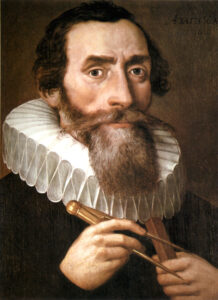Who was Johannes Kepler?
Short Biography
 Johannes Kepler was born at 2:30 PM on December 27, 1571, in Weil der Stadt, near Stuttgart, in the Holy Roman Empire. His family was Lutheran and he adhered to the Augsburg Confession. This adherence later caused him hardships. He was a sickly child and his parents were poor. But his evident intelligence earned him a scholarship to the University of Tübingen. There he was introduced to and delighted in the ideas of Copernicus. In 1596, holding the position of Matematicus (professor of astronomy and astrology) in Graz, he wrote the first outspoken defense of the Copernican system, the Mysterium Cosmographicum.
Johannes Kepler was born at 2:30 PM on December 27, 1571, in Weil der Stadt, near Stuttgart, in the Holy Roman Empire. His family was Lutheran and he adhered to the Augsburg Confession. This adherence later caused him hardships. He was a sickly child and his parents were poor. But his evident intelligence earned him a scholarship to the University of Tübingen. There he was introduced to and delighted in the ideas of Copernicus. In 1596, holding the position of Matematicus (professor of astronomy and astrology) in Graz, he wrote the first outspoken defense of the Copernican system, the Mysterium Cosmographicum.
Kepler was forced to leave his teaching post at Graz due to the counter Reformation because he was Lutheran and moved to Prague to work with the renowned Danish astronomer, Tycho Brahe. He inherited Tycho’s post as Imperial Mathematician when Tycho died in 1601. Using the precise data that Tycho had collected, Kepler discovered that the orbit of Mars was an ellipse. In 1609 he published Astronomia Nova, delineating his discoveries, which are now called Kepler’s first two laws of planetary motion. This work established Kepler as the “father of modern science”, documenting how for the first time a scientist dealt with a multitude of imperfect data to arrive at a fundamental law of nature.
In 1612 Lutherans were forced out of Prague, so Kepler moved on to Linz. His wife and two sons had recently died. He remarried happily, but had many personal and financial troubles. Two infant daughters died and Kepler had to return to Württemberg where he successfully defended his mother against charges of witchcraft. In 1619 he published Harmonices Mundi, in which he describes his “third law.”
In spite of more forced relocations, Kepler published the seven-volume Epitome Astronomiae in 1621. This was his most influential work and discussed all of heliocentric astronomy in a systematic way. He then went on to complete the Rudolphine Tables that Tycho had started long ago. These included calculations using logarithms, which he developed, and provided perpetual tables for calculating planetary positions for any past or future date. Kepler used the tables to predict a pair of transits by Mercury and Venus of the Sun, although he did not live to witness the events.
Johannes Kepler died in Regensburg in 1630, while on a journey from his home in Sagan to collect a debt. His grave was demolished within two years because of the Thirty Years War. Frail of body, but robust in mind and spirit, Kepler was scrupulously honest to the data.
A List of Kepler's Firsts
- First to correctly explain planetary motion, thereby, becoming founder of celestial mechanics and the first “natural laws” in the modern sense; being universal, verifiable, precise.
In his book Astronomia Pars Optica, for which he earned the title of founder of modern optics he was the:
- First to investigate the formation of pictures with a pin hole camera;
- First to explain the process of vision by refraction within the eye;
- First to formulate eyeglass designing for nearsightedness and farsightedness;
- First to explain the use of both eyes for depth perception.
In his book Dioptrice (a term coined by Kepler and still used today) he was the:
- First to describe: real, virtual, upright and inverted images and magnification;
- First to explain the principles of how a telescope works;
- First to discover and describe the properties of total internal reflection.
In addition:
- His book Stereometrica Doliorum formed the basis of integral calculus.
- First to explain that the tides are caused by the Moon (Galileo derided him for this).
- First to use stellar parallax caused by the Earth’s orbit to try to measure the distance to the stars; the same principle as depth perception. Today this branch of research is called astrometry.
- First to suggest that the Sun rotates about its axis in Astronomia Nova
- First to derive the birth year of Christ, that is now universally accepted.
For additional information, please visit the Kepler Museum in Weil der Stadt by the Kepler-Gesellschaft e. V.


